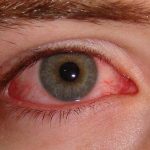 Sore, red and sticky eyes caused by eye infection.
Sore, red and sticky eyes caused by eye infection.
Inflammation of the mucous membranes of the eye or eyelid.
Inflammation of the conjunctiva, generally associated with discharge.
Inflammation of the mucous membrane lining of the eyelids and covering of the anterior part of the eyeball.
A contagious eye disease commonly known as pink eye that causes eyes to turn red and/or produce pus.
Pertaining to an inflammation of the conjunctiva of the eye.
Inflammation of the membrane that covers the eye when closed.
Inflammation of the mucous membrane lining of the eyelids and the front of the eye, caused by bacterial or viral infection, allergy, or irritation. The eyes look pink; the eyelids are stuck together in the morning, and there is discomfort, but usually not pain. Treatment depends on the cause. Also called pinkeye.
Inflamed, reddened, and swollen conjunctivae with dilated blood vessels; it has a variety of causes, including foreign substance in the eye, mechanical irritation, or dryness.
Inflammation of the membrane lining the eyelids and the exposed outer surface of the eye (conjunctiva). Popularly known as pinkeye, conjunctivitis is the most common eye disease in the Western hemisphere. The disease’s severity ranges from mild to severe. Symptoms can include redness, irritation and pain, excessive tearing, itching, blurred vision, a grainy or gritty feeling in the eye, increased sensitivity to light, and crusts that form on the eyelids overnight.
Inflammation of the conjunctiva, which becomes red and swollen and produces a watery or pus-containing discharge. It causes discomfort rather than pain and does not usually affect vision. Conjunctivitis is caused by infection (in which case it usually spreads rapidly to the other eye), allergy, or physical or chemical irritation. The patient usually recovers with no after-effects in one to three weeks; bacterial infections respond to antibiotic eye drops.
Inflammation of the mucous membrane (conjunctiva) lining the inside of the eyelids.
Common bacterial infection of the eyes; extremely contagious.
An inflammation of the conjunctiva, caused by an allergic reaction or by a bacterial or viral infection.
Conjunctivitis, commonly known as pink eye, refers to the inflammation of the conjunctiva a delicate mucous membrane that coats the inner surfaces of the eyelids and the anterior portion of the eyeball.
Conjunctivitis is the inflammation of the conjunctiva, resulting in redness, discomfort, and the release of discharge from the affected eye.
There are two common types of conjunctivitis: infective conjunctivitis, caused by bacteria or viruses, and allergic conjunctivitis, which occurs as an allergic reaction to substances like cosmetics and pollen. Both types can exhibit similar symptoms. In infective conjunctivitis, the discharge typically contains pus and may lead to the eyelids sticking together upon waking in the morning. In allergic conjunctivitis, the discharge is clear, and the eyelids often become swollen and itchy.
In addition to the more common types, there are several less frequent forms of conjunctivitis. These include neonatal ophthalmia, which is an infective eye disease that occurs in newborns; keratoconjunctivitis, characterized by inflammation in both the conjunctiva and the cornea; and trachoma, a severe type of chlamydial infection.
Bacterial infections are typically managed with the application of antibiotic eye drops or ointment. In the case of viral conjunctivitis, treatment is often unnecessary as the condition tends to resolve on its own. Allergic conjunctivitis, on the other hand, may be treated with antihistamine or corticosteroid eye drops that contain cromoglicate to alleviate symptoms.
Inflammation of the conjunctiva is characterized by redness, congestion, and discomfort in the white part of the eye, often accompanied by a sensation of grittiness beneath the eyelids. In severe cases, individuals may find ordinary daylight too harsh to tolerate. The redness is a result of the inflammatory process, stemming from the dilation of blood vessels that traverse the white of the eye.
